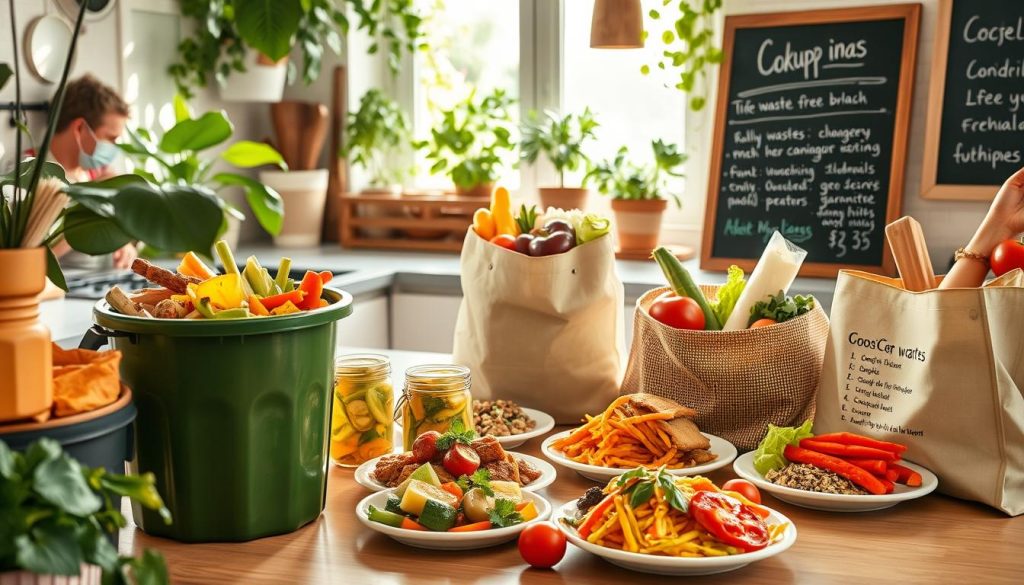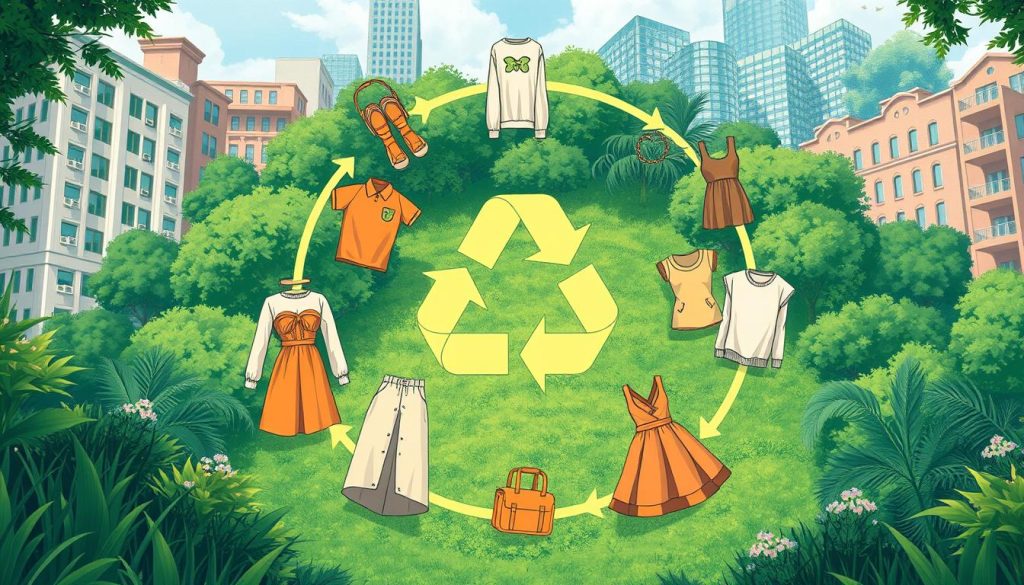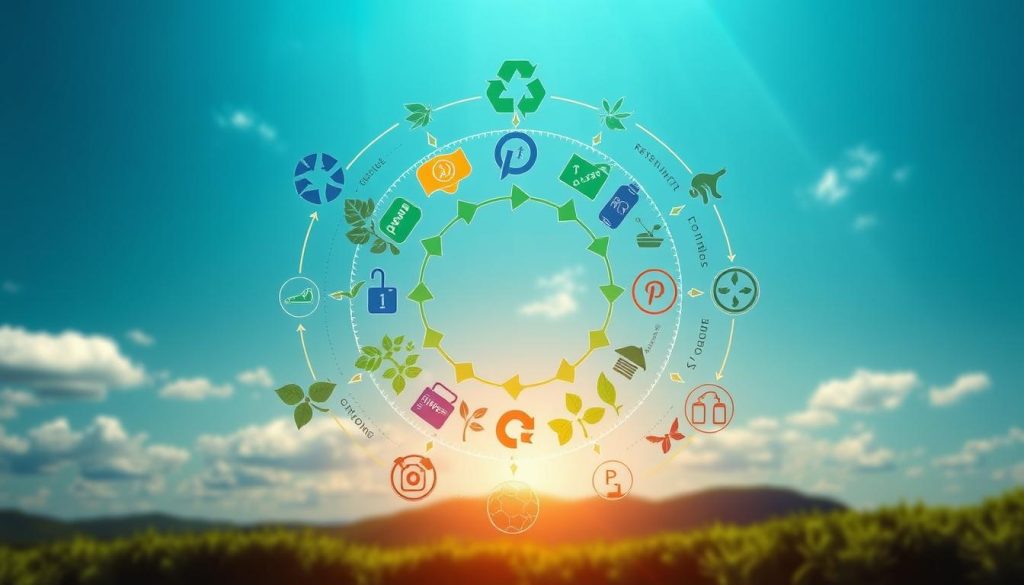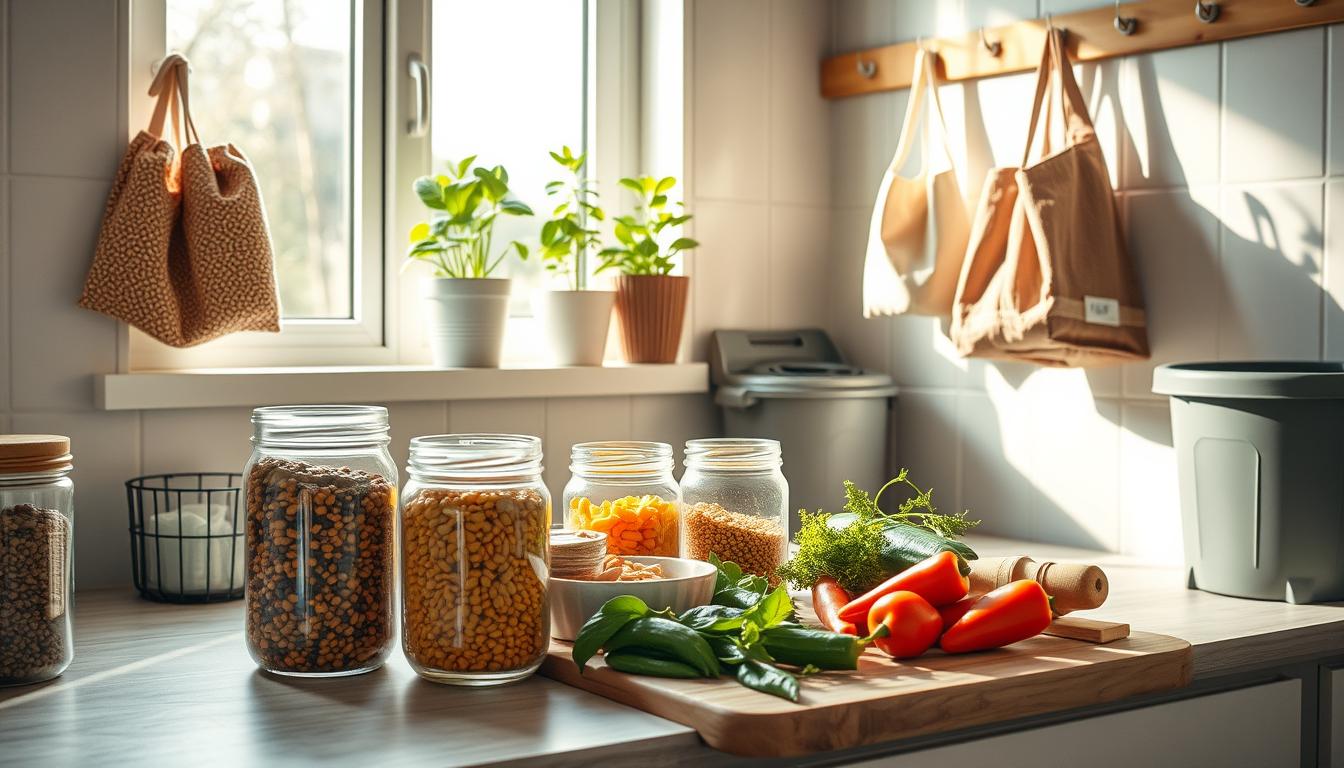I’ve found a way to grow my savings and help the planet. It’s called zero waste living. This lifestyle isn’t just about cutting down on trash. It’s also a smart way to save money and reduce our carbon footprint.
By reducing waste, I’ve seen how zero waste can save money. Simple changes like using reusable bags and making cleaning products at home make a big difference. Plus, it’s better for the environment. With less waste, we use fewer resources and keep our Earth healthy.
Want to join me on this journey? Let’s see how zero waste can help your wallet and the planet. It’s time to change our daily habits for the better of both our finances and our planet.
Understanding the Zero Waste Lifestyle
Embracing a zero waste lifestyle is more than a trend. It’s a powerful way to help our planet and save money. Let’s explore what zero waste means and how it benefits us all.
Defining Zero Waste and Its Principles
Zero waste is about changing how we use resources. It’s not just about recycling. It’s a system to reduce waste. The aim is to send nothing to landfills.
This means we reuse, reduce, and rethink before recycling or throwing things away.
Waste Reduction and Financial Savings
Reducing waste can also save money. By buying less and using reusable items, we save over time. For example, a reusable water bottle saves money after a few uses compared to bottled water.
These small changes lead to big savings over time.
Environmental Benefits of Zero Waste
Adopting zero waste helps build a circular economy. It keeps resources in use longer, reducing the need for new materials. This cuts pollution, lowers carbon emissions, and protects ecosystems.
I’ve seen how focusing on resource efficiency protects our environment.
By understanding and applying these principles, we can help a sustainable future and save money. It’s a win-win situation I’m excited to be part of.
Cost-saving Benefits of Zero Waste
Embracing a zero waste lifestyle has saved me money and helped the environment. It focuses on sustainable production and energy conservation. This has led to big savings in my daily expenses.
One major benefit is cutting down on disposable item costs. Switching to reusable items has reduced my monthly spending. This includes paper towels, plastic bags, and disposable water bottles.
Energy conservation has also saved me money. I’ve bought energy-efficient appliances and adopted habits like turning off lights. My utility bills have gone down a lot.
Recycling has added to my savings too. I sell recyclable materials like aluminum cans and glass bottles. It’s not a lot, but it helps with other expenses.
- Reduced spending on disposable items
- Lower utility bills through energy conservation
- Extra income from recycling initiatives
The financial perks of zero waste living are obvious. Making smart choices about what we consume and waste helps the planet and our wallets. It’s a great way to save money and help the environment at the same time.
Getting Started: Simple Zero Waste Swaps
Starting a zero waste journey is easy. Small changes can make a big difference. Let’s look at some easy swaps and DIY solutions that help the environment and save money.
Reusable Alternatives to Common Disposables
Switching to reusable items is key. I use a stainless steel water bottle instead of disposable ones. This saves money and cuts down on plastic waste. I also use cloth napkins and towels in my kitchen, which saves on paper products.
DIY Solutions for Everyday Products
Making your own products is fun and sustainable. I make multipurpose cleaners with vinegar and citrus peels. They’re effective and cheap. I also make toothpaste with baking soda and coconut oil, which is a big hit in my bathroom.
Calculating Long-Term Savings
I’ve tracked my spending to see the financial benefits. Here’s a yearly cost comparison for some common items:
| Item | Disposable Cost | Reusable Cost | Yearly Savings |
|---|---|---|---|
| Water Bottles | $365 | $20 | $345 |
| Coffee Cups | $730 | $25 | $705 |
| Cleaning Products | $120 | $30 | $90 |
These simple swaps help reduce waste and save money. By choosing reusable items, I’ve cut my environmental impact and saved a lot of cash.
Reducing Food Waste and Saving on Groceries

Food waste is a big problem that hurts our wallets and the planet. I’ve learned that cutting down on waste can save a lot of money and help the environment. Let’s look at some ways to make our kitchens more efficient.
Meal planning is a big help. Making a weekly menu and shopping list helps me avoid buying things I don’t need. This simple step saves money and reduces waste.
Smart shopping is also key. Buying in bulk for non-perishables and choosing loose produce saves money and reduces packaging waste. It’s a win-win.
Storing food right is important to keep it fresh longer. I use airtight containers and know how to store different foods. This cuts down on food waste.
| Food Item | Storage Method | Estimated Shelf Life |
|---|---|---|
| Leafy Greens | Wrapped in damp paper towel, in a sealed bag | 1-2 weeks |
| Berries | Unwashed, in a single layer in a container | 5-7 days |
| Bread | In a bread box or paper bag at room temperature | 3-5 days |
Composting is a big part of my waste reduction plan. It helps manage food waste and makes great soil for my garden. It’s good for the planet and saves money on fertilizers.
By using these strategies, I’ve cut my grocery bills and helped the environment. It’s a great way to save money and protect our planet.
Minimizing Energy Consumption for Lower Bills
Reducing energy use is a smart move to save money and help the environment. Making a few simple changes can cut our carbon footprint and lower utility bills.
Energy-efficient Appliances: A Wise Investment
Switching to energy-efficient appliances has changed my life. These devices use less power, saving me money over time. For instance, my ENERGY STAR certified fridge uses 15% less energy than old models. This cuts my electricity costs and supports sustainable production.
Simple Habits for Energy Conservation
Small daily changes can greatly reduce energy use. I’ve adopted these habits:
- Turning off lights when leaving a room
- Using natural light whenever possible
- Unplugging electronics not in use
- Setting thermostats a few degrees lower in winter and higher in summer
Exploring Renewable Energy Options
I’ve started looking into renewable energy like solar panels. The initial cost is high, but the long-term benefits are huge. Solar energy cuts down on fossil fuel use, supports sustainable production, and can lead to zero energy bills. It’s a great way to save energy and reduce carbon footprint.
Sustainable Fashion: Saving Money and Resources

I’ve found that sustainable fashion is good for my wallet and the planet. By using a circular economy in my wardrobe, I cut down on waste and save money. Let’s see how we can make our closets more eco-friendly and affordable.
Buying second-hand clothes is my favorite choice. Thrift stores and online sites have great deals on used items. I’ve scored designer pieces for a small fraction of their original price, showing that you don’t have to spend a lot to look good.
Clothing swaps are another smart way to update your wardrobe without spending anything. I host swap events with friends, where we exchange clothes we no longer want. It’s a fun way to help the environment and save money.
Investing in quality, durable clothes is key for sustainable fashion. I look for timeless styles made from materials that last. Although these items might cost more at first, they save money over time by lasting longer than cheap, fast-fashion clothes.
| Fast Fashion | Sustainable Fashion |
|---|---|
| Low initial cost | Higher upfront investment |
| Frequent replacements | Longer-lasting items |
| High environmental impact | Reduced waste and emissions |
| Trend-driven | Timeless styles |
By following these sustainable fashion tips, I’ve cut down my clothing costs and reduced my environmental impact. It’s a great way to help the planet and save money in our daily lives.
Zero Waste in the Workplace: Boosting Efficiency and Cutting Costs
Businesses are finding out that going green can save a lot of money. I’ve seen how companies change to use resources better and make more money.
Implementing paperless strategies
Switching to digital documents is a smart move. It cuts down on paper, ink, and storage costs. This change also makes work flow better and helps the planet.
Creating a culture of resource conservation
Getting employees on board is key to zero waste success. Companies teach staff about saving resources and reward green actions. This leads to new ideas and a lasting commitment to saving resources.
Cost benefits for businesses adopting zero waste practices
Zero waste is good for the wallet. Companies see lower costs, a better image, and more loyal customers. For instance, a factory I visited saved 50% on waste by recycling and reusing materials.
| Zero Waste Practice | Average Cost Savings | Environmental Impact |
|---|---|---|
| Paperless Office | 15-30% on office supplies | 40% reduction in paper waste |
| Energy Efficiency Measures | 20-40% on energy bills | 30% decrease in carbon emissions |
| Waste Recycling Program | 10-25% on waste management | 60% increase in materials recycled |
Adopting zero waste helps businesses save money and help the planet. It’s a good deal for everyone.
The Circular Economy: Rethinking Consumption and Production

I’ve been looking into the circular economy, and it’s really interesting. This new way of thinking aims to cut down on waste and use resources better. It’s different from our old “take-make-dispose” way, where we just throw things away.
In a circular economy, products are made to last longer and can be fixed easily. When they can’t be used anymore, they’re broken down and their parts are used again. This method not only cuts down on waste but also opens up new business chances.
Companies are beginning to follow this model. For instance, some furniture makers now create pieces that can be updated or fixed, making them last longer. Tech companies are also starting to take back old devices, fixing them up to sell again.
As consumers, we have a big part to play in the circular economy. By picking products that last longer and supporting companies that do things sustainably, we help make goods that are better for the planet. Renting, sharing, and buying used items are also smart choices.
| Linear Economy | Circular Economy |
|---|---|
| Take-make-dispose model | Reduce-reuse-recycle model |
| Single-use products | Durable, repairable products |
| Waste accumulation | Waste minimization |
| Resource depletion | Resource conservation |
By going for the circular economy, we can build a greener future. It’s good for businesses and the planet. It’s a win-win situation.
Community Initiatives: Collective Savings Through Zero Waste
Working together as a community can save us money and help the environment. Let’s see how local efforts can make a big difference.
Local Recycling Programs and Their Economic Impact
Many cities now have recycling programs that cut waste and create jobs. These programs save money by reducing trash collection fees. In my town, recycling has cut waste management costs by 15% in two years.
Collaborative Consumption Models in Neighborhoods
Sharing economy practices are growing in my area. Tool libraries, community gardens, and clothing swaps are popular. They help us save money and build community.
My neighbors and I started a tool-sharing program. It saves each household about $200 a year on items they don’t use often.
Supporting Zero Waste Businesses in Your Area
Local zero waste shops are becoming common. They offer package-free goods and refill stations. Supporting these shops reduces waste and saves money on quality products.
Since shopping at our local zero waste store, I’ve cut my waste by 40%. My grocery bills have also gone down!
By joining these community initiatives, we can save money and reduce waste. It’s amazing how small changes can make a big difference when we work together.
Measuring Your Progress: Tools for Tracking Waste Reduction and Savings
Tracking my zero waste journey keeps me motivated. There are many apps and tools to help. I use a carbon footprint calculator to see my environmental impact. It’s thrilling to see my carbon emissions decrease!
For tracking money, I use a simple spreadsheet. I record my spending on reusable items and compare it to disposable costs. The savings grow quickly! This method keeps me focused on reducing waste and shows the benefits of zero waste living.
Setting goals is crucial for improving resource efficiency. I aim to cut my trash by half each month. When I hit a goal, I reward myself with something eco-friendly. This positive feedback helps me stay committed to zero waste habits. By tracking progress, I see how small changes lead to big waste and savings reductions.

